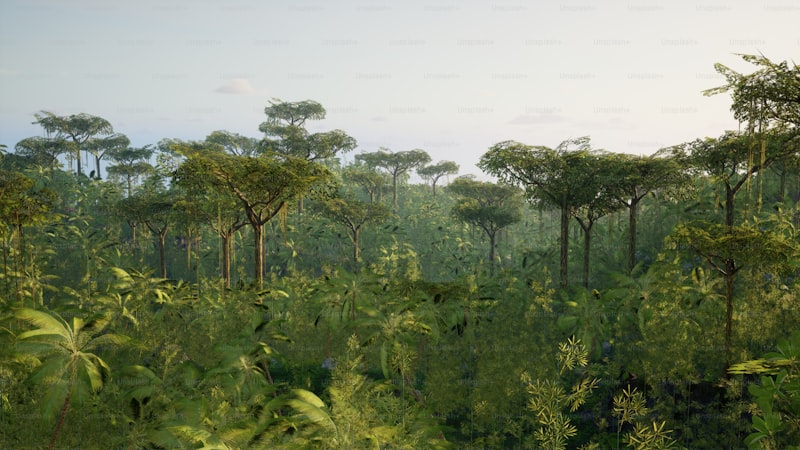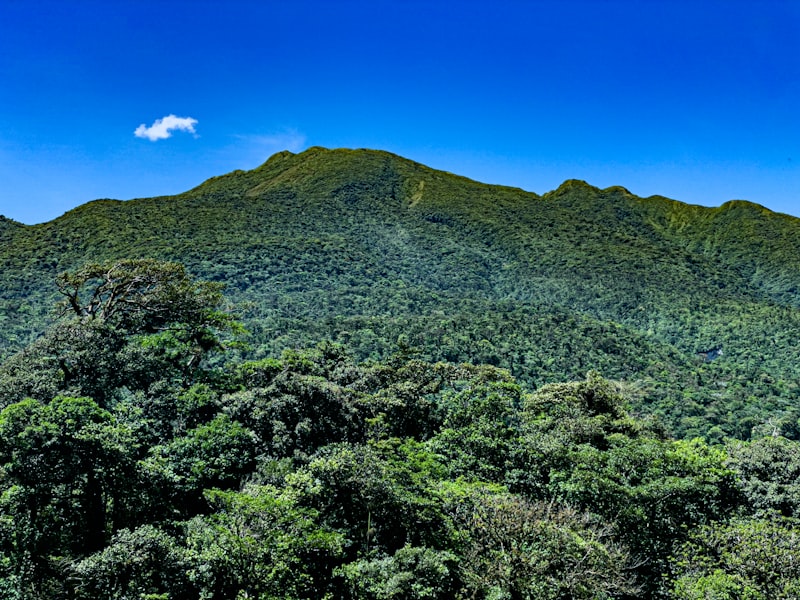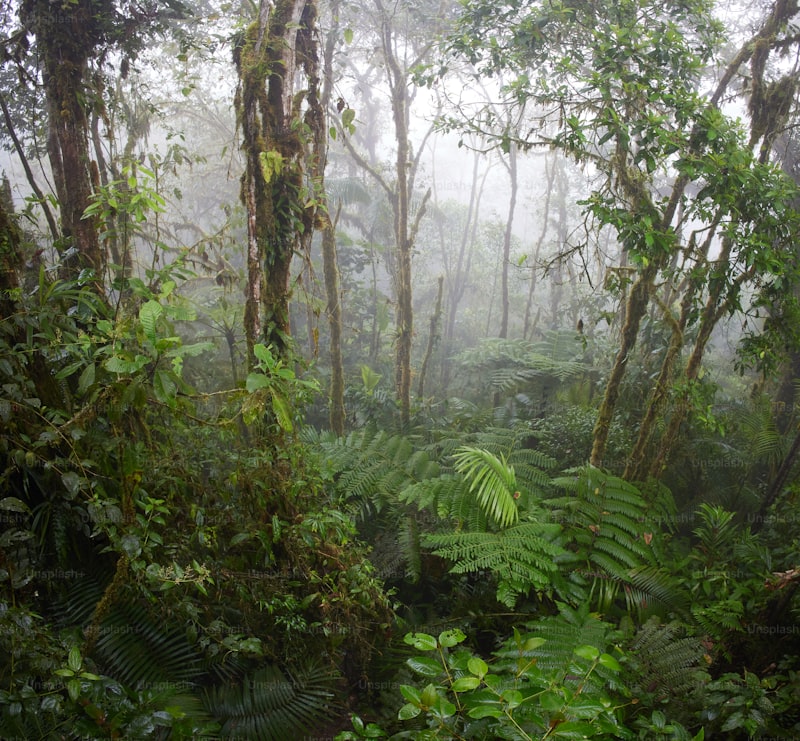Imagine stepping into a world where every shade of green dances before your eyes, where sunlight filters through a dense canopy to create patterns that seem straight out of a painter’s palette. This is the enchanting first impression of a rainforest – a place where nature showcases its mastery in creating breathtaking landscapes.
But there’s more than just beauty here. Rainforests are veritable storehouses of biodiversity, housing millions of species that call these dense jungles home. From the majestic jaguar prowling stealthily to the vibrant macaw flashing its colors overhead, each creature plays a crucial role in maintaining the delicate balance of this ecosystem.

The allure of rainforests lies not only in their biological richness but also in their essential role in stabilizing our planet’s climate. Often referred to as the “lungs of the Earth,” these forests absorb carbon dioxide and produce oxygen, making them vital players in the global fight against climate change. Their preservation is not just an environmental concern but a necessity for the well-being of our entire planet.
As you delve deeper into a rainforest, you’ll encounter layers of life intertwined in a complex web of relationships. Giant trees rise like ancient guardians, their roots anchoring the forest floor and providing habitats for countless organisms. It’s a bustling community where each plant, insect, and animal contributes to the symphony of nature, creating a tapestry of life that is as awe-inspiring as it is intricate.
Yet, these majestic rainforests face unprecedented threats from deforestation, climate change, and human exploitation. The delicate balance that sustains this ecosystem is under constant pressure, urging us to rethink our relationship with nature and take proactive steps to protect these invaluable treasures.
Exploring the Enchanting Biodiversity of Verdant Rainforests
Rainforests, with their dense canopy and rich undergrowth, are veritable treasure troves of life. From the towering trees that form the upper canopy to the myriad plants and creatures on the forest floor, every layer of the rainforest pulses with vitality. It’s like stepping into a living, breathing kaleidoscope of nature’s finest creations.
At the heart of rainforest biodiversity are the trees themselves. Towering giants like the mighty kapok and majestic mahogany provide not only shelter but also serve as anchors for an entire ecosystem. Their broad leaves and tangled branches create a microclimate that supports a staggering variety of life forms, from tiny insects to brightly colored birds and elusive mammals.
But it’s not just the trees that make rainforests so enchanting. The forest floor, often dimly lit and carpeted with fallen leaves and ferns, harbors a world of its own. Here, countless species of plants, fungi, and insects engage in a complex dance of survival and reproduction. Each organism plays a crucial role in maintaining the delicate balance of the ecosystem.
One of the most fascinating aspects of rainforest biodiversity is its sheer diversity. In just one hectare of Amazonian rainforest, scientists have documented an astonishing array of species, many of which are found nowhere else on Earth. This biodiversity is not just a spectacle; it’s also a source of potential cures for diseases, inspiration for innovations in technology, and models for sustainable living.
As we continue to explore and understand the enchanting biodiversity of rainforests, it becomes clear that these ecosystems are not just beautiful—they are essential to the health of our planet. By preserving rainforests and supporting efforts to conserve their biodiversity, we are not only protecting countless species but also safeguarding our own future.
So, the next time you find yourself surrounded by the sights and sounds of a verdant rainforest, take a moment to marvel at the wonders of biodiversity that unfold before you. It’s a reminder of nature’s resilience and a call to action to preserve these precious ecosystems for generations to come.
Secrets of Survival: How Wildlife Thrives in Verdant Rainforests
Amidst the towering canopy and dense undergrowth, competition for resources is fierce. Animals have evolved remarkable strategies to secure their place in this competitive arena. Take, for instance, the clever camouflage of the leaf-tailed gecko, perfectly blending into the foliage to evade predators and quietly hunt its prey. This adaptation not only ensures its survival but also exemplifies nature’s artistry in deception.
In these rainforests, the concept of symbiosis thrives. Creatures forge intricate partnerships where each participant benefits. The iconic relationship between flowers and pollinators, such as hummingbirds and butterflies, ensures the perpetuation of plant species while providing nourishment for the pollinators themselves. It’s a dance of mutual dependence and mutual gain, finely tuned over millennia of coexistence.

Yet, survival in the rainforest demands more than camouflage and cooperation. It requires resilience in the face of constant change. Seasonal floods can transform the landscape overnight, pushing animals to adapt or perish. Species like the Amazonian poison dart frog have evolved potent toxins as a defense mechanism against predators, turning their small size into an advantage that echoes through the forest.
Above all, the rainforest is a testament to adaptation’s ingenuity. From the prehensile tail of the spider monkey to the razor-sharp hunting skills of the jaguar, each adaptation is a testament to the relentless drive to survive and thrive in a world where every advantage counts.
Unveiling the Hidden Treasures Within Verdant Rainforests
Imagine stepping into a world where towering trees create a canopy so dense that sunlight filters through like specks of gold. Here, life thrives in abundance, from the smallest insects to majestic creatures like the jaguar and the elusive harpy eagle. Each species plays a crucial role in maintaining the delicate balance of this ecosystem, where every plant and animal is interconnected in a web of life.
But beyond its breathtaking biodiversity, rainforests offer a treasure trove of natural wonders that have fascinated explorers and scientists for centuries. Medicinal plants with potent healing properties, like the vibrant rosy periwinkle of Madagascar, have revolutionized modern medicine with treatments for leukemia and Hodgkin’s disease.
Moreover, these forests act as the Earth’s lungs, absorbing carbon dioxide and producing oxygen on a scale vital for our planet’s health. They regulate global climate patterns and influence weather systems far beyond their borders, underscoring their indispensable role in mitigating climate change.
Yet, despite their immense value, rainforests face unprecedented threats from deforestation, driven by agriculture, logging, and urban expansion. Each day, swathes of these irreplaceable ecosystems disappear, taking with them undiscovered species and potential cures.

As we delve deeper into understanding rainforests, we uncover not just their ecological significance but also their cultural and spiritual importance to indigenous peoples worldwide. These forests are repositories of ancient wisdom and cultural heritage, offering profound lessons in coexistence with nature.
Eco-Tourism Adventures: Discovering Verdant Rainforests Around the Globe
Imagine stepping into the Amazon rainforest, where towering trees create a natural cathedral, and vibrant macaws paint the sky with their kaleidoscopic plumage. Here, every rustle and chirp tell tales of survival and symbiosis, where the circle of life unfolds in its purest form.
Or perhaps your eco-quest leads you to the Daintree Rainforest in Australia, where ancient ferns and moss-covered trees whisper secrets of a prehistoric past. As you trek through this living museum, you encounter species found nowhere else on the planet, like the elusive cassowary or the vivid Ulysses butterfly.
For those seeking a rendezvous with endangered giants, Borneo’s rainforests offer a chance to witness orangutans swinging gracefully through the canopy. Here, conservation efforts intertwine with eco-tourism, providing a glimpse into the delicate balance between humanity and nature.
In Costa Rica, the Monteverde Cloud Forest Reserve casts a mystical spell with its ethereal mist and a tapestry of epiphytes clinging to every branch. It’s a haven for bird watchers, where resplendent quetzals flaunt their iridescent plumage, and hummingbirds dart like tiny jewels amidst the greenery.
Each rainforest enclave holds a unique story, a narrative woven by centuries of evolution and the custodianship of indigenous communities. Through responsible eco-tourism, we become not just spectators but stewards of these ecosystems, ensuring they thrive for generations to come.
So, are you ready to trade bustling cityscapes for the tranquil embrace of verdant rainforests? Embark on this eco-adventure, where every step unveils a new wonder and every encounter leaves an indelible mark on your soul. Join us in discovering the ultimate harmony between man and nature, where conservation meets exploration in the world’s most captivating jungles.
Frequently Asked Questions
What threats do rainforests face today?
Discover the current threats facing rainforests today, including deforestation, climate change, illegal logging, and habitat fragmentation. Learn about these pressing issues and their impact on biodiversity and global climate.
How can we protect and conserve rainforests?
Discover effective ways to protect and conserve rainforests through sustainable practices such as reforestation, supporting local communities, promoting eco-tourism, and advocating for policies that enforce responsible logging and land use.
How do rainforests contribute to global climate regulation?
Discover how rainforests play a crucial role in global climate regulation by absorbing carbon dioxide, producing oxygen, and stabilizing climate patterns through evapotranspiration.
Why are rainforests important for indigenous cultures?
Learn why rainforests are crucial for indigenous cultures, providing essential resources, cultural identity, and sustainable livelihoods. Understand their profound connection to these ecosystems and their efforts in conservation.
What makes rainforests so biodiverse?
Discover what makes rainforests incredibly biodiverse through their unique combination of climate, geography, and evolutionary history. Explore how these factors contribute to the wide variety of plant and animal species found in these rich ecosystems.


